Royal London is in a right Royal mess. Not unfortunately the Royal family, an institution I would only be too pleased to see go bust, unlikely for various reasons though that is, but the Royal London Hospital, which managed quite well for the 250 years before it became Royal, but is now in trouble.
Its old building, dating from the 1750s was updated in the nineteenth century and again at the start of the twentieth, but by the twentyfirst was a mess. When I wandered around its corridors a few years ago, failing to follow the confusing signage, it still seemed a place where Flo Nightingale would have been at home, and sitting in the waiting area in the entrance or standing under the outside portico in recent years was to be in a curious limbo, with patients, some pushing drips on stands, slowly towards the ‘fresh air’ of the Whitechapel Road for a fag.
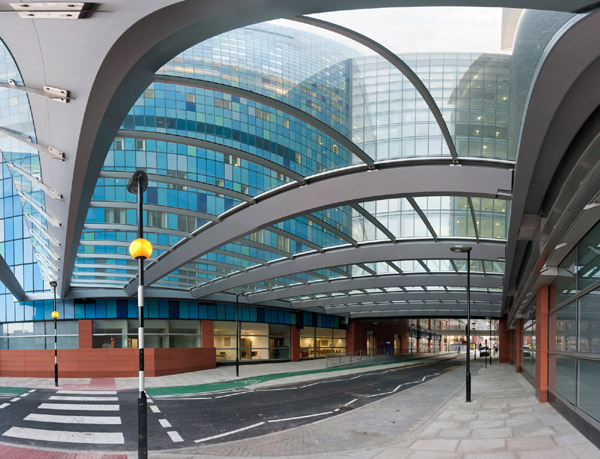
Royal London Hospital, Stepney Way, Dec 2011
Now its all shiny new and blue, part of one of many Private Finance Initiative (PFI) schemes which are crippling the NHS. Conceived under John Major, PFI never made sense other than as a trick to make government borrowing look less than it really was. At the start, Labour opposed it, but in government went on to use the scam to a huge extent to provide new schools and hospitals in a number of disastrous schemes. The one including the Royal London was the largest of all in the NHS at £1.1 billion, and Barts Health Trust has to find £129 million this year to pay the private companies involved – an annual amount that will rise to £274 million by 2048.
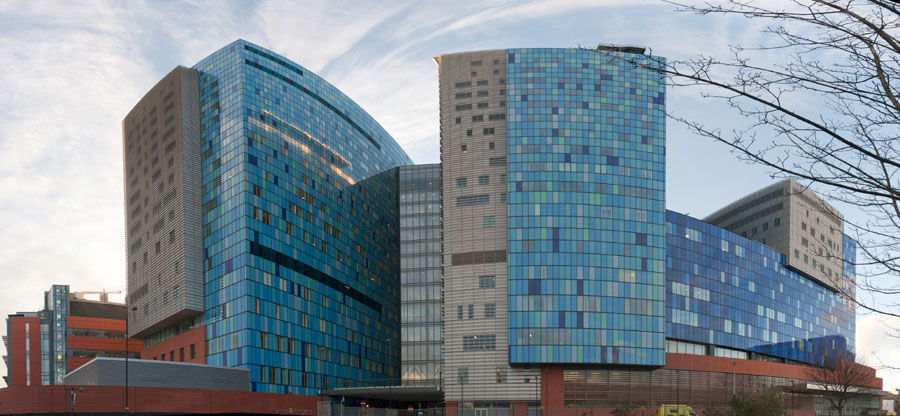
Royal London Hospital from Cavell St, Dec 2011 Some views from it at Whitechapel – Hospital Views
Unsurprisingly this huge amount means they can’t afford to run health services in the area properly. They can’t even open the new hospital fully, unable to staff two floors, and are making huge cuts at other hospitals and of community services too. Hospital staff are suffering, having to try to provide services with a lack of nurses and other support – and of course the people of East London will not get the service they deserve. There are staff cuts, and also downgrading, with staff being paid on lower rates than their training and experience merit. Community Health services are being severely cut and sold off. The only winners are the companies who financed the PFI deals, and whose experienced negotiators often managed to completely outwit the civil servants in setting the terms.
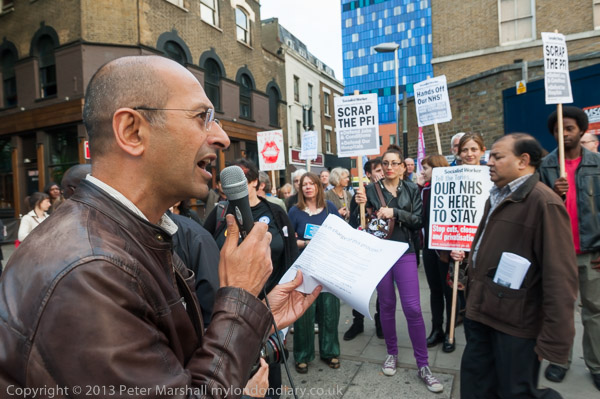
Staff at all the hospitals in the group (and others around the country who are also affected by PFI schemes) are angry at the cuts that are having to be made to pay rich private investors, and are calling for these PFI schemes to be scrapped. The protesters at the Royal London were initially refused permission to protest in front of the hospital, but enough turned up to block the busy pavement opposite Whitechapel Station in the evening rush hour that police moved them there.
I was pleased as a photographer, because the fairly narrow pavement made it difficult to work – the 22mm view above makes it look less crowded than it was, and most of those present are out of picture to the right – and this was also the only position from which the hospital – the blue building in the centre – could be seen.
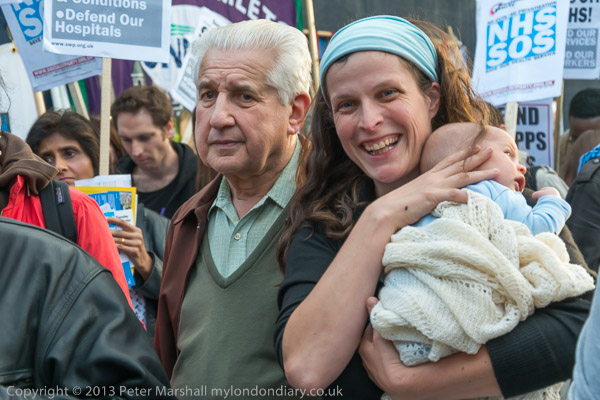
Though working in the crowd there did provide some good opportunities for pictures. I particularly liked this because of the spread of ages and the contrasting expressions of the man listening to the speeches and the woman carrying the child who is laughing because she has seen me taking her picture. This was the second or third frame, and at first she was looking concerned, but I think this makes a better picture. A little later I took another picture of her and behind her a man with a child on his shoulders in which she again looks serious – you can see it in Scrap Royal London NHS PFI Debt – but I think this is a better picture.
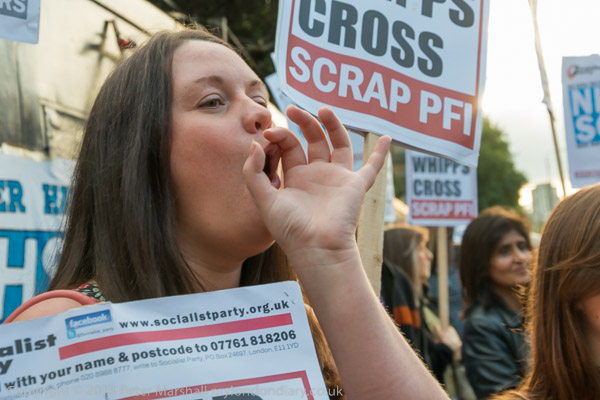
There were also some more active protesters, including this nurse shouting in support of a speaker from the Royal College of Nursing, the largest nurses’ union. Whipp’s Cross, where she works, is another of the Barts Health NHS Trust which is suffering hugely from the Royal London PFI. I was standing fairly close to her – I couldn’t get any further away in the crowd, and though this is taken with the 28-105mm at 48mm (67mm equiv) it does have just a hint of what is sometimes called wide-angle distortion, which I think makes it a little more dramatic. You can see too the lighting from the low sun, which also slightly restricted the choice of point of view when working. Here I’ve moved to put it just behind the placard above the woman’s hand – and you can see it has made just a little bite out of the edge of it.
After the police got the protest to move, the speakers were in front of the new hospital buildings, which was better in terms of context, but not necessarily more exciting pictorially, particularly as everything was now in shade. The audience was also more organised, with many behind the large main banner. Of course banners are important, but they do also get rather in the way.
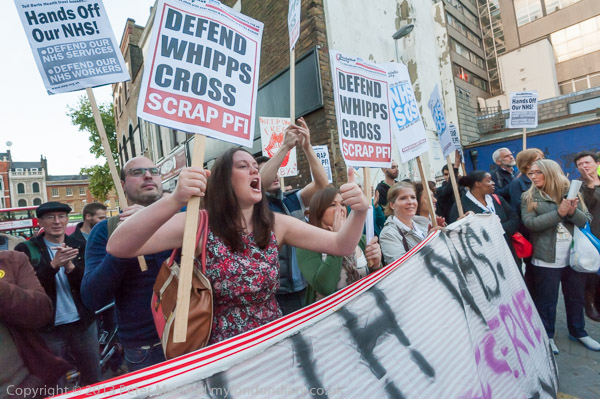
I’d stood for some while trying to photograph again the nurse I’d photographed earlier, who was reacting strongly every time a speaker made a point or called for a response, and was at the front just behind the banner. But when I moved in close she stopped. I tried for a while, then moved a couple of yards back, standing behind a man who was filming in the opposite direction, towards the speaker. As she reacted, I moved in and took pictures including this one above (16mm D700), only to find a woman tugging at my sleeve to try and get me to move. They now wanted to film in the direction where I was standing. Well, tough. I wouldn’t normally deliberately move into someone else’s picture, and hadn’t done so in this case, and I expect a reasonable degree of respect from other photographers and videographers. This was a protest and not a set for TV. Once I’d got the picture I wanted I moved out of the way. They could get their ‘reaction shot’ without me the next time the crowd erupted. But I was shocked by their bad manners.
______________________________________________________
My London Diary : Buildings of London : River Lea/Lee Valley : London’s Industrial Heritage
All photographs on this and my other sites, unless otherwise stated, are taken by and copyright of Peter Marshall, and are available for reproduction or can be bought as prints.
To order prints or reproduce images
________________________________________________________